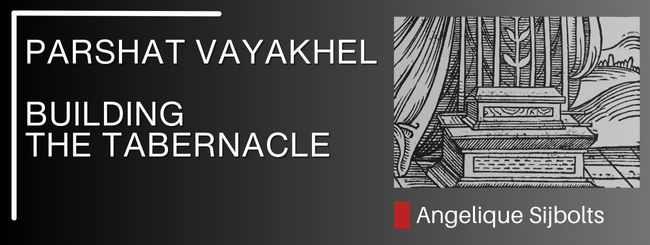בס”ד
PARSHAT VAYAKHEL 5784
LESSONS FOR TODAY’S WORLD
| And everyone who excelled in ability and everyone whose spirit was moved came, bringing to Hashem an offering for the work of the Tent of Meeting and for all its service and for the sacral vestments. | וַיָּבֹ֕אוּ כָּל־אִ֖ישׁ אֲשֶׁר־נְשָׂא֣וֹ לִבּ֑וֹ וְכֹ֡ל אֲשֶׁר֩ נָֽדְבָ֨ה רוּח֜וֹ אֹת֗וֹ הֵ֠בִ֠יאוּ אֶת־תְּרוּמַ֨ת יְ”הֹוָ֜ה לִמְלֶ֨אכֶת אֹ֤הֶל מוֹעֵד֙ וּלְכָל־עֲבֹ֣דָת֔וֹ וּלְבִגְדֵ֖י הַקֹּֽדֶשׁ | |
| Men and women, all whose hearts moved them, all who would make an elevation offering of gold to Hashem, came bringing brooches, earrings, rings, and pendants —gold objects of all kinds. | וַיָּבֹ֥אוּ הָֽאֲנָשִׁ֖ים עַל־הַנָּשִׁ֑ים כֹּ֣ל | נְדִ֣יב לֵ֗ב הֵ֠בִ֠יאוּ חָ֣ח וָנֶ֜זֶם וְטַבַּ֤עַת וְכוּמָז֙ כָּל־כְּלִ֣י זָהָ֔ב וְכָל־אִ֕ישׁ אֲשֶׁ֥ר הֵנִ֛יף תְּנוּפַ֥ת זָהָ֖ב לַֽי”הֹוָֽה |
Moses stood before the people, his voice shrouded in the silence of anticipation. It was a moment of sacred calling, as he summoned the people to discuss the construction of the Tabernacle, a home for the presence of G-d among His people Israel.
The people came together, a diverse collection of individuals, each with their own motives and heartbeat. Some understood the importance of the project and felt the inner urge to contribute, modestly and logically considering what they could spare. Others were swept away by the excitement of the great work before them, giving generously, sometimes even beyond their limits, without thinking of their own abilities.
G-d looked upon them all with loving eyes, for everything the people gave, they gave with love. But it was remarkable that the Scripture mentioned the second category of people first, those who gave everything they had without hesitation. They were the ones who could most easily let go of what was most precious to them. This teaches us that if we want to give something to G-d, we must give what is most precious to us.
For the women, their jewelry was a precious possession. A possession they would not have wanted to give up for the golden calf. Then, the men had to take it from them, now they gave it willingly.
Why did the Scripture specify these jewels? It could have simply said that the women gave their jewelry. It teaches us that each person has something unique, something specific that they want to give to G-d. What I give is not the same as what someone else gives or vice versa, and in G-d’s eyes, one gift is not more or less valuable than another, every gift is precious.
Years later, Rabbi Avraham Ibn Ezra would reveal a deeper meaning behind these jewels. They symbolized the four essential contributions that parents, educators, and teachers must make to transform the world into a better place.
The time, effort, and money we invest in raising our children are precious gifts to G-d, to make the world a habitable place, a Tabernacle, for Him.
The earrings represented listening to the instructions of the Torah on how to raise our children. The nose rings symbolized the importance of developing a keen sense of smell for beneficial friendships. Not only physical friendships but in this day and age, we must also not forget the friendships on social media. We need to know who our children chat with, TikTok with, which “friends” they follow. The finger rings pointed to gently guiding children onto the right path, while the bracelets emphasized that sometimes a strong hand is needed to keep them on the straight and narrow.
The construction of the Tabernacle, while a historical event, still holds profound meaning and relevance today. It symbolizes not only the physical construction of a holy place for G-d but also the creation of an environment where His presence can be felt and His values can be lived.
In our modern era, as the challenges and needs of the world evolve, we must still build with the same dedication to this “Tabernacle.” We must focus our efforts on raising our children with love, respect, and values that enable them to serve themselves and others. We must build a world where no one is left behind, where everyone has the opportunity to thrive and reach their full potential.
Through our collective efforts, we can strengthen G-d’s presence in our world and be a source of inspiration and hope for generations to come.
Learning Points
1. Giving to G-d: Learn from the Israelites’ willingness to offer their most precious possessions for the Tabernacle, teaching us the value of sacrificial giving in our own spiritual journey.
2. Parental Guidance: Reflect on Rabbi Avraham Ibn Ezra’s insights into the symbolism of the donated jewelry, emphasizing the essential role parents play in guiding and nurturing children with wisdom, discernment, and discipline.
3. Contemporary Relevance: Explore how the construction of the Tabernacle resonates in today’s world, inspiring us to build communities of faith, compassion, and justice, where God’s presence can dwell among us.
By Angelique Sijbolts
Sources:
Ibn Ezra on Exodus 35:21:1
Or HaChaim on Exodus 35:21:1/
Ramban on Exodus 35:21:1
© Copyright, all rights reserved. If you enjoyed this article, we encourage you to distribute it further.
Our blogs may contain texts/ quotes/references/links of
Mechon-Mamre.org, Aish.com, Sefaria.org, Chabad.org AskNoah.org
that contain copyrights and which we may use with there permission.
